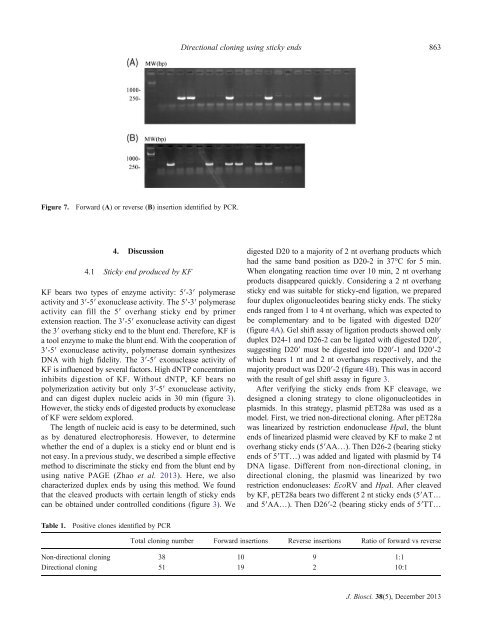Realizing directional cloning using sticky ends produced by 3′-5 ...
Realizing directional cloning using sticky ends produced by 3′-5 ...
Realizing directional cloning using sticky ends produced by 3′-5 ...
Create successful ePaper yourself
Turn your PDF publications into a flip-book with our unique Google optimized e-Paper software.
Directional <strong>cloning</strong> <strong>using</strong> <strong>sticky</strong> <strong>ends</strong> 863<br />
Figure 7.<br />
Forward (A) or reverse (B) insertion identified <strong>by</strong> PCR.<br />
4. Discussion<br />
4.1 Sticky end <strong>produced</strong> <strong>by</strong> KF<br />
KF bears two types of enzyme activity: 5′-<strong>3′</strong> polymerase<br />
activity and <strong>3′</strong>-5′ exonuclease activity. The 5′-<strong>3′</strong> polymerase<br />
activity can fill the 5′ overhang <strong>sticky</strong> end <strong>by</strong> primer<br />
extension reaction. The <strong>3′</strong>-5′ exonuclease activity can digest<br />
the <strong>3′</strong> overhang <strong>sticky</strong> end to the blunt end. Therefore, KF is<br />
a tool enzyme to make the blunt end. With the cooperation of<br />
<strong>3′</strong>-5′ exonuclease activity, polymerase domain synthesizes<br />
DNA with high fidelity. The <strong>3′</strong>-5′ exonuclease activity of<br />
KF is influenced <strong>by</strong> several factors. High dNTP concentration<br />
inhibits digestion of KF. Without dNTP, KF bears no<br />
polymerization activity but only <strong>3′</strong>-5′ exonuclease activity,<br />
and can digest duplex nucleic acids in 30 min (figure 3).<br />
However, the <strong>sticky</strong> <strong>ends</strong> of digested products <strong>by</strong> exonuclease<br />
of KF were seldom explored.<br />
The length of nucleic acid is easy to be determined, such<br />
as <strong>by</strong> denatured electrophoresis. However, to determine<br />
whether the end of a duplex is a <strong>sticky</strong> end or blunt end is<br />
not easy. In a previous study, we described a simple effective<br />
method to discriminate the <strong>sticky</strong> end from the blunt end <strong>by</strong><br />
<strong>using</strong> native PAGE (Zhao et al. 2013). Here, we also<br />
characterized duplex <strong>ends</strong> <strong>by</strong> <strong>using</strong> this method. We found<br />
that the cleaved products with certain length of <strong>sticky</strong> <strong>ends</strong><br />
can be obtained under controlled conditions (figure 3). We<br />
digested D20 to a majority of 2 nt overhang products which<br />
had the same band position as D20-2 in 37°C for 5 min.<br />
When elongating reaction time over 10 min, 2 nt overhang<br />
products disappeared quickly. Considering a 2 nt overhang<br />
<strong>sticky</strong> end was suitable for <strong>sticky</strong>-end ligation, we prepared<br />
four duplex oligonucleotides bearing <strong>sticky</strong> <strong>ends</strong>. The <strong>sticky</strong><br />
<strong>ends</strong> ranged from 1 to 4 nt overhang, which was expected to<br />
be complementary and to be ligated with digested D20′<br />
(figure 4A). Gel shift assay of ligation products showed only<br />
duplex D24-1 and D26-2 can be ligated with digested D20′,<br />
suggesting D20′ must be digested into D20′-1 and D20′-2<br />
which bears 1 nt and 2 nt overhangs respectively, and the<br />
majority product was D20′-2 (figure 4B). This was in accord<br />
with the result of gel shift assay in figure 3.<br />
After verifying the <strong>sticky</strong> <strong>ends</strong> from KF cleavage, we<br />
designed a <strong>cloning</strong> strategy to clone oligonucleotides in<br />
plasmids. In this strategy, plasmid pET28a was used as a<br />
model. First, we tried non-<strong>directional</strong> <strong>cloning</strong>. After pET28a<br />
was linearized <strong>by</strong> restriction endonuclease HpaI, the blunt<br />
<strong>ends</strong> of linearized plasmid were cleaved <strong>by</strong> KF to make 2 nt<br />
overhang <strong>sticky</strong> <strong>ends</strong> (5′AA…). Then D26-2 (bearing <strong>sticky</strong><br />
<strong>ends</strong> of 5′TT…) was added and ligated with plasmid <strong>by</strong> T4<br />
DNA ligase. Different from non-<strong>directional</strong> <strong>cloning</strong>, in<br />
<strong>directional</strong> <strong>cloning</strong>, the plasmid was linearized <strong>by</strong> two<br />
restriction endonucleases: EcoRV and HpaI. After cleaved<br />
<strong>by</strong> KF, pET28a bears two different 2 nt <strong>sticky</strong> <strong>ends</strong> (5′AT…<br />
and 5′AA…). Then D26′-2 (bearing <strong>sticky</strong> <strong>ends</strong> of 5′TT…<br />
Table 1.<br />
Positive clones identified <strong>by</strong> PCR<br />
Total <strong>cloning</strong> number Forward insertions Reverse insertions Ratio of forward vs reverse<br />
Non-<strong>directional</strong> <strong>cloning</strong> 38 10 9 1:1<br />
Directional <strong>cloning</strong> 51 19 2 10:1<br />
J. Biosci. 38(5), December 2013
















